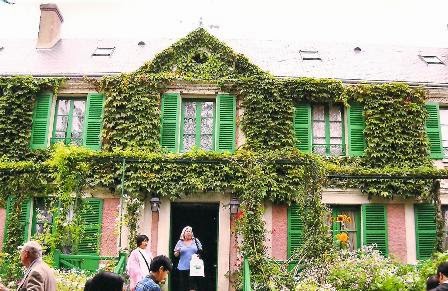I was
excited to learn we were going to make an unscheduled stop—to Monet’s home and
gardens! The highlight of this trip was Normandy so it was a real bonus.
Claude
Monet noticed the village of Giverny while looking out of a train window. He
made up his mind to move there and rented a house and the area surrounding it.
In 1890 he had enough money to buy the house and land outright and set out to
create the magnificent gardens he wanted to paint. Monet lived in Giverny from
1883 until his death in 1926. He and many members of his family are interred in
the village cemetery.
Following
restoration, Monet's house and gardens were opened to the public in 1980.We
wandered around the lily ponds first and over the stream bridges. The beautiful
gardens were so quiet and peaceful. Still
 |
| Monet's home |
Monet
initially painted the countryside, but after buying the house, he began
transforming the gardens. He used different heights to create volume.
Fruit trees or ornamental trees dominate the climbing roses, the long-stemmed
hollyhocks and the colored banks of annuals. Monet mixed the simplest flowers,
daisies and poppies, with the rare varieties.
 |
| Part of his water garden |
We
spent a lot of time on the gardens, and eventually moved into the house. The
original house was much smaller than it is today. Monet enlarged it on both
sides. Monet loved color and chose all the colors in the home. The house is
pink with green shutters—a marked deviation of the normal grey shutters of
Victorian times. The barn next to the house became his first studio, thanks to
the addition of a wooden floor and of stairs leading to the main
house. Monet, who mostly painted in the open air, needed a place to finish
and his store canvases.
Monet
added a gallery in front of the house; a pergola covered with climbing roses,
and grew a Virginia creeper on the façade---he wanted the house to blend with
the garden.
Blue is
used extensively throughout the home. The dining room though is painted a
vibrant yellow with blue tiles to coordinate with the blue kitchen when the
door was open. Walls showcased Japanese engravings that Monet chose with an
expert eye. For fifty years, he collected the prints by the best Japanese
artists.
Monet
was one of few who became famous during his lifetime, although he had to wait
until he was fifty before he was recognized as a master.
It was a
thrilling visit that definitely put Giverny on my revisit list!

No comments:
Post a Comment